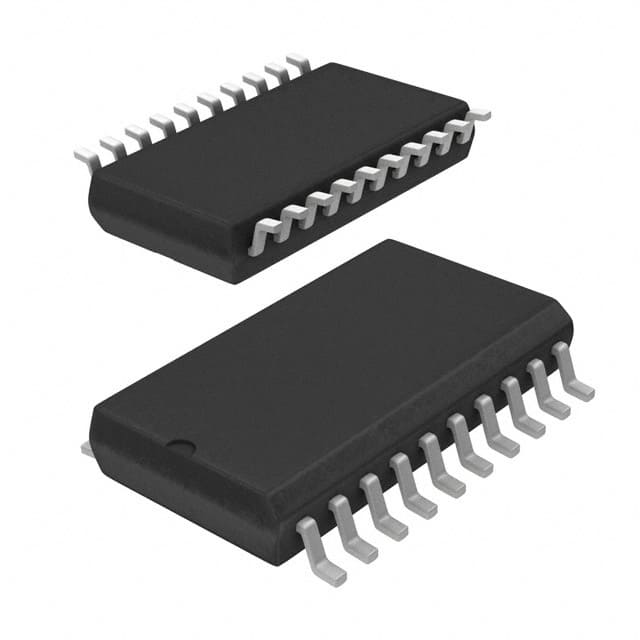Consulte las especificaciones para obtener detalles del producto.

SN74AS245DWRG4
Product Overview
- Category: Integrated Circuit
- Use: Bus Transceiver
- Characteristics: High-speed, bidirectional data transfer, voltage level shifting
- Package: SOIC (Small Outline Integrated Circuit)
- Essence: Transfers data between two bidirectional buses with different voltage levels
- Packaging/Quantity: Tape and Reel, 2500 units per reel
Specifications
- Supply Voltage Range: 4.5V to 5.5V
- Input Voltage Range: 0V to VCC
- Output Voltage Range: 0V to VCC
- Operating Temperature Range: -40°C to +85°C
- Number of Pins: 20
- Logic Family: AS (Advanced Schottky)
Detailed Pin Configuration
- DIR (Direction Control)
- GND (Ground)
- B1 (Bus B Data Bit 1)
- B2 (Bus B Data Bit 2)
- B3 (Bus B Data Bit 3)
- B4 (Bus B Data Bit 4)
- B5 (Bus B Data Bit 5)
- B6 (Bus B Data Bit 6)
- B7 (Bus B Data Bit 7)
- B8 (Bus B Data Bit 8)
- VCC (Supply Voltage)
- A1 (Bus A Data Bit 1)
- A2 (Bus A Data Bit 2)
- A3 (Bus A Data Bit 3)
- A4 (Bus A Data Bit 4)
- A5 (Bus A Data Bit 5)
- A6 (Bus A Data Bit 6)
- A7 (Bus A Data Bit 7)
- A8 (Bus A Data Bit 8)
- OE (Output Enable)
Functional Features
- Bidirectional data transfer between two buses
- Voltage level shifting for compatibility between different voltage levels
- High-speed operation for efficient data transmission
- Output enable control for disabling the outputs when not in use
Advantages and Disadvantages
Advantages: - Enables communication between buses with different voltage levels - Fast data transfer speeds - Compact SOIC package for space-saving designs
Disadvantages: - Limited to a specific number of data bits (8 in this case) - Requires careful consideration of voltage compatibility between buses
Working Principles
The SN74AS245DWRG4 is a bus transceiver that facilitates bidirectional data transfer between two buses, typically with different voltage levels. It operates by using a direction control pin (DIR) to determine the flow of data between the buses. When DIR is set to logic high, data flows from Bus A to Bus B, and when DIR is set to logic low, data flows from Bus B to Bus A.
The integrated circuit incorporates voltage level shifting functionality, allowing it to translate signals between buses operating at different voltage levels. This feature ensures compatibility and seamless communication between systems with varying voltage requirements.
The output enable pin (OE) provides control over the outputs. When OE is set to logic high, the outputs are enabled, allowing data to be transferred. Conversely, setting OE to logic low disables the outputs, preventing any data transfer.
Detailed Application Field Plans
The SN74AS245DWRG4 finds applications in various fields where bidirectional data transfer between buses with different voltage levels is required. Some common application areas include:
- Industrial Automation: Facilitating communication between different subsystems operating at different voltage levels.
- Automotive Electronics: Enabling data exchange between various vehicle systems with varying voltage requirements.
- Telecommunications: Supporting data transmission between different network interfaces.
- Consumer Electronics: Facilitating communication between different components within electronic devices.
Detailed and Complete Alternative Models
- SN74LVC245APW: Low Voltage CMOS Bus Transceiver
- SN74HC245N: High-Speed CMOS Logic Level Shifter
- SN74LVCH245ADBR: Low-Voltage CMOS Octal Bus Transceiver
These alternative models offer similar functionality to the SN74AS245DWRG4 but may have different specifications, pin configurations, or package options. It is important to select the appropriate alternative based on specific requirements and constraints.
Word count: 525 words
Enumere 10 preguntas y respuestas comunes relacionadas con la aplicación de SN74AS245DWRG4 en soluciones técnicas
Sure! Here are 10 common questions and answers related to the application of SN74AS245DWRG4 in technical solutions:
Q: What is SN74AS245DWRG4? A: SN74AS245DWRG4 is a bidirectional octal bus transceiver with 3-state outputs, commonly used for level shifting and signal buffering in digital systems.
Q: What is the voltage range supported by SN74AS245DWRG4? A: SN74AS245DWRG4 supports a voltage range of 2V to 6V.
Q: How many data lines can SN74AS245DWRG4 handle? A: SN74AS245DWRG4 can handle 8 data lines, as it is an octal (8-bit) transceiver.
Q: Can SN74AS245DWRG4 be used for both input and output operations? A: Yes, SN74AS245DWRG4 can be used for bidirectional data transfer, allowing both input and output operations.
Q: What is the maximum data transfer rate supported by SN74AS245DWRG4? A: SN74AS245DWRG4 supports a maximum data transfer rate of 24 MHz.
Q: Does SN74AS245DWRG4 have built-in protection against overvoltage or ESD events? A: No, SN74AS245DWRG4 does not have built-in protection against overvoltage or ESD events. External protection measures may be required.
Q: Can SN74AS245DWRG4 be used in both 3.3V and 5V systems? A: Yes, SN74AS245DWRG4 is compatible with both 3.3V and 5V systems, making it versatile for various applications.
Q: What is the power supply voltage range for SN74AS245DWRG4? A: The power supply voltage range for SN74AS245DWRG4 is typically between 4.5V and 5.5V.
Q: Can SN74AS245DWRG4 handle high-speed data transmission? A: Yes, SN74AS245DWRG4 is designed to handle high-speed data transmission, making it suitable for applications requiring fast signal transfer.
Q: Are there any specific layout considerations when using SN74AS245DWRG4? A: Yes, it is recommended to follow the layout guidelines provided in the datasheet to minimize noise and ensure proper signal integrity.
Please note that these answers are general and may vary depending on the specific application and requirements. It is always advisable to refer to the datasheet and consult with technical experts for accurate information.

